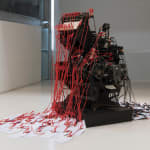mounir fatmi Morocco, b. 1970
The Index and the Machine 01, 2016
Linotype, starter cables, papers and wooden base.
1.000 kg. 180 x 226 x 160 cm.
Further images
-
(View a larger image of thumbnail 1
)

-
(View a larger image of thumbnail 2
)

-
(View a larger image of thumbnail 3
)

-
(View a larger image of thumbnail 4
)

-
(View a larger image of thumbnail 5
)

-
(View a larger image of thumbnail 6
)

-
(View a larger image of thumbnail 7
)

-
(View a larger image of thumbnail 8
)

The Index and the Machine is a word association used in Western history since the Renaissance, during which time the printing machine originated. Soon thereafter the first Index (the list...
The Index and the Machine is a word association used in Western history since the Renaissance, during which time the printing machine originated. Soon thereafter the first Index (the list of prohibited books by the Church) was published.
The printing machine changed writing, literature and especially culture, in all its aspects. Until its creation, some instruments and tools had allowed a controlled circulation of religious ideas. Nevertheless, it wasn’t until its creation that books experienced a massive diffusion. As an instrument devoted to democracy, it quickly became a vehicle for the expansion of multiple ideas. However, the accession of the printing machine also brought censorship and ideological control to its peak. A proof of this was the first published text, the Bible, which served as a model, but also imposed a form of restriction that impeded the diffusion and evolution of other more advanced theories. Since then, the Church published normative texts such as the List of Prohibited Books (Index librorum prohibitorum), which wasn’t formally abolished until 1966. Throughout these four centuries, many of the leading philosophers and writers such as Voltaire, Sartre, Spinoza, Locke Proudhon, Saint-Simon, Flaubert, and Descartes, were “mis à l’index”¹, and their works were accused of being ‘pernicious’ by the Catholic Church.
In this installation, fatmi traces this problematic and brings to light the paradoxical duality faced by the mechanization of writing, a once ancestral technique. The central theme is that of censorship, which is dealt with through various aspects. More broadly the artist poses questions to the visitor about the concept of culture and history. Taking the opposite view of the idea expressed by the Index, seen here as a reflection of the "universalist" culture that prevailed over four centuries throughout the Catholic West.
Finally, the installation, The Index and The Machine, proposes a deep examination of certain topics to which fatmi tries to respond -such as the effects of hegemonic discourses, history, interpretation, memory and identity. Those topics are also present over the whole of his artistic production.
The printing machine changed writing, literature and especially culture, in all its aspects. Until its creation, some instruments and tools had allowed a controlled circulation of religious ideas. Nevertheless, it wasn’t until its creation that books experienced a massive diffusion. As an instrument devoted to democracy, it quickly became a vehicle for the expansion of multiple ideas. However, the accession of the printing machine also brought censorship and ideological control to its peak. A proof of this was the first published text, the Bible, which served as a model, but also imposed a form of restriction that impeded the diffusion and evolution of other more advanced theories. Since then, the Church published normative texts such as the List of Prohibited Books (Index librorum prohibitorum), which wasn’t formally abolished until 1966. Throughout these four centuries, many of the leading philosophers and writers such as Voltaire, Sartre, Spinoza, Locke Proudhon, Saint-Simon, Flaubert, and Descartes, were “mis à l’index”¹, and their works were accused of being ‘pernicious’ by the Catholic Church.
In this installation, fatmi traces this problematic and brings to light the paradoxical duality faced by the mechanization of writing, a once ancestral technique. The central theme is that of censorship, which is dealt with through various aspects. More broadly the artist poses questions to the visitor about the concept of culture and history. Taking the opposite view of the idea expressed by the Index, seen here as a reflection of the "universalist" culture that prevailed over four centuries throughout the Catholic West.
Finally, the installation, The Index and The Machine, proposes a deep examination of certain topics to which fatmi tries to respond -such as the effects of hegemonic discourses, history, interpretation, memory and identity. Those topics are also present over the whole of his artistic production.








